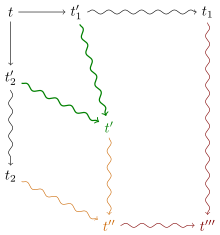|
Newman's lemmaIn mathematics, in the theory of rewriting systems, Newman's lemma, also commonly called the diamond lemma, states that a terminating (or strongly normalizing) abstract rewriting system (ARS), that is, one in which there are no infinite reduction sequences, is confluent if it is locally confluent. In fact a terminating ARS is confluent precisely when it is locally confluent.[1] Equivalently, for every binary relation with no decreasing infinite chains and satisfying a weak version of the diamond property, there is a unique minimal element in every connected component of the relation considered as a graph. Today, this is seen as a purely combinatorial result based on well-foundedness due to a proof of Gérard Huet in 1980.[2] Newman's original proof was considerably more complicated.[3] Diamond lemma Given t1 tt2, perform an induction on the derivation length. Obtain t′ from local confluence, and t′′ from the induction hypothesis; similar for t′′′. In general, Newman's lemma can be seen as a combinatorial result about binary relations → on a set A (written backwards, so that a → b means that b is below a) with the following two properties:
The lemma states that if the above two conditions hold, then → is confluent: whenever a b and a c, there is an element d such that b d and c d. In view of the termination of →, this implies that every connected component of → as a graph contains a unique minimal element a, moreover b a for every element b of the component.[4] Notes
References
Textbooks
External links
|
Portal di Ensiklopedia Dunia